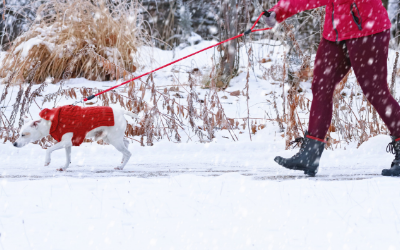
Some dogs love the snow – they roll in it, eat it, and love to chase snowballs, while others would rather curl up by a cozy fire at their owner’s feet. Whatever your dog prefers, it’s important that he’s prepared for the elements: snow, ice, freezing temperatures, and salt on the sidewalks.
Here are some tips on keeping your dog protected this winter:
Booties. Booties may not be loved by all dogs, but they do help protect your dog’s paws from salt, ice balls, and cold temperatures. Be sure to get properly fitting boots. Many stores will allow you to try the boots on your pet in the store or at home. Use the manufacturer’s guidelines for sizing. Make sure they’re easy to get on and off – but not too easy – you don’t want Fido removing them as soon as you strap them on!
If you can’t convince your dog to wear booties, there are other solutions that offer protection.
Trimmed feet. It’s important to keep the hair on your dog’s feet trimmed short. This is especially true for dogs with a long haircoat. Keeping the hair trimmed will help prevent ice balls from forming between your dog’s toes, which can be very painful to walk on.
Protective balms. Much like lip balm, balms are available for your dog’s paw pads. These create a protective barrier between the paw pads and the icy, salt-covered sidewalks. A thin layer of balm can be applied on your dog’s feet just before you head out for a wintery walk and wiped off with a towel upon your return, removing any salt residue. Another thin layer can be applied and massaged into your dog’s pads to help keep them from drying out.
Salt and deicers. Avoid using salt and deicers on your walkways and avoid heavily salted sidewalks and roads. In addition to being toxic if consumed (directly eaten off the ground or licked off paws once inside), these chemicals are harsh on your pet’s pads. Wash or wipe your dog’s paws with warm water or warm water on a cloth to remove the chemicals and prevent your pet from licking the residue off.
Coats and sweaters. Not all dogs need an extra layer for warmth (Siberian Huskies are probably okay without a coat!), but some dogs, especially those that are short-haired or smaller-sized, need a sweater or coat to keep them warm on cold winter days. Dogs are susceptible to hypothermia just as humans are and can easily get frostbite on unprotected skin (ears, tail, and paws). On extremely cold days, shorten your walks and pay attention to the cues that your dog is too cold: shivering, anxiety (crying or yelping), and tugging at the leash to go home.
If you suspect that your pet has frostbite, move your pet to a warm, dry area as quickly as possible. Contact your veterinarian or emergency clinic immediately. While getting further instructions, warm your dog slowly by wrapping him in warm towels or blankets. You can place hot water bottles wrapped in towels near his body. DO NOT rub your dog’s skin. DO NOT use direct dry heat (hair dryer or heating pad). Keep your dog warm while transporting him to your veterinarian by wrapping him in towels or blankets that have been warmed in a clothes dryer.
With a few precautions and preparation, winter can be a magical time of year with your furry companion!